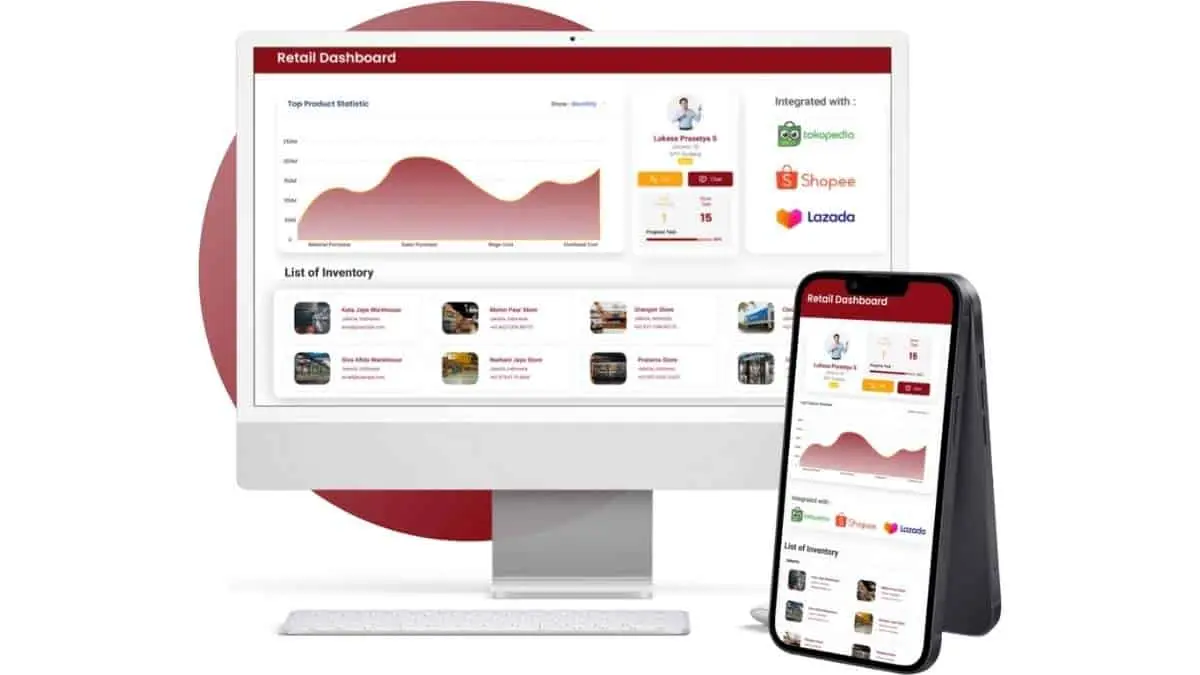Cross-selling presents a strategic opportunity to increase profits, especially for businesses offering multiple related products, such as in retail. While this term may be less familiar, customers often encounter this tactic designed to meet additional needs.
Recommending the right products and managing customer perceptions can challenge retail selling. Managers find that an overly aggressive approach can reduce customer satisfaction and result in lost revenue.
According to BusinessWorld, companies in the Philippines have achieved revenue boosts of up to 15% through practical cross-selling tools. Retail Systems can support this by simplifying customer and transaction management in one seamless platform.
This article delves into key strategies for successful cross-selling and the software solutions that enhance this process. Continue reading to discover how the best retail management system can help you maximize the potential of retail selling in your business.
Table of Contents
Key Takeaways
|
What is Cross-Selling in Retail?
Cross-selling in retail is a strategy that recommends products complementing a customer’s initial purchase, enhancing satisfaction, and boosting sales. This widely used approach is one of the most effective marketing methods across industries.
Retail selling creates more opportunities to add value to a customer’s experience through thoughtful recommendations in retail. For example, when a customer buys a smartphone, suggesting items like a protective case or screen protector is a simple yet effective cross sell example.
Retail selling also applies beyond retail, as seen in financial services, where institutions might offer multiple products to a single client. For instance, if a bank client has a mortgage, the sales team might cross-sell a savings product or a personal line of credit.
Combining cross-selling with upselling strategies within a retail management system enables companies to meet more of their customers’ needs while maximizing the value of each sales interaction.
Key Considerations for Effective Cross-Selling Techniques

Implementing cross-selling techniques effectively requires a strategic approach that goes beyond simply suggesting additional products. Businesses must carefully consider customer preferences, product relevance, and timing to enhance the likelihood of successful cross-sales.
By focusing on these key factors, companies can create a positive cross sell experience that benefits both the customer and the brand.
1. Avoid pressuring customers with cross-selling
The goal is to offer items that genuinely appeal to and add value to customers. If done genuinely, they’ll appreciate your thoughtful suggestions. Avoid coercive tactics, as this can lead to customers leaving without making a purchase.
2. Recommend relevant products only
Only suggest products or services related to what the customer plans to buy. For example, if a customer recently purchased a refrigerator, don’t ask them if they want to see your new 3D television. Instead, ask them if they want to buy an extra-pure water filter for it.
If you suggest an unrelated product, the customer will quickly discover that you are just trying to increase sales without considering their needs. The customer will not believe your intentions and will go elsewhere.
3. Listen actively to customers
Paano mo malalaman ang eksaktong kailangan ng isang customer?
Please get to know customers and listen to clues to their complaints. For example, a customer might want a DVD player with excellent picture quality for home movie playback. You can suggest a player equipped with a home theater system that will enhance their viewing experience.
If you listen to your customers, you will likely understand their preferences and needs. You can also use a complete sales management system to boost your sales team’s productivity by selling smarter, faster, and more effectively.
4. Don’t over-sell
If you start offering too many products, the customer may become confused or suspect you are selling to make more money than trying to help him. Limit yourself to providing an additional product or two unless prior experience strongly encourages customers to buy more.
To streamline your cross-selling approach, consider using reliable retail management software that helps you optimize product recommendations without overwhelming customers. Click the banner below to calculate the pricing options that fit your business needs!

5. Prioritize the customer experience
To be successful in this technique, you must make the customer the main focus. The customer will immediately notice if the main objective is to make money. Many failures occur because the employee’s actual profit-seeking intentions are so evident that the idea is that the business doesn’t care about them. Only offering products related to customer purchases can increase customer satisfaction.
Advantages and Disadvantages of Cross-Selling

Cross-selling offers businesses valuable opportunities to enhance customer satisfaction and increase revenue. However, like any strategy, it has its strengths and potential drawbacks. Understanding the advantages and disadvantages of cross-selling can help businesses use it effectively while avoiding common pitfalls.
Advantages
Cross-selling is a powerful tactic businesses use to boost revenue by meeting more of their customers’ needs. It’s more than just suggesting additional products; it requires understanding consumer behaviour, their needs, and how complementary products can add value.
With the right approach, cross selling can significantly strengthen customer loyalty and trust.
- Boosts revenue: Retail selling increases sales quantities, especially for less popular items, leading to higher overall revenue.
- Strengthens customer loyalty: Customers who buy more products from a brand often become more loyal and are less likely to switch to competitors.
- Meets customer needs: Offering related products ensures customers find everything they need, reducing the chance of shopping elsewhere.
- Improves customer satisfaction: By providing relevant product recommendations, cross-selling enhances the customer experience.
- Enhances brand image: Successfully cross-selling shows customers that the brand understands and meets their needs, improving its reputation.
Disadvantages
However, cross-selling also has potential downsides if not approached thoughtfully. Executing poorly can damage customer relationships and even harm the brand’s reputation. An overly aggressive approach can lead customers to perceive it as a pushy sales tactic, driving them away rather than encouraging repeat business.
- Increases service costs: More products sold may increase service demands, raising operational costs.
- Risk of appearing pushy: Overly aggressive cross sell can create a negative impression and pressure customers.
- Potential for brand damage: Cross-selling without understanding customer needs may harm the brand’s reputation if perceived as self-serving.
- Complicated sales process: Too many additional suggestions can overwhelm customers and deter them from purchasing.
- Profitability challenges with returns: Cross-selling to customers with high return rates can lead to losses instead of gains due to refunds or payment defaults.
Retail selling requires a strategic balance. By aligning the approach with genuine customer needs, companies can leverage it to enhance customer satisfaction and business performance.
Boost Your Business Profits with Cross-Selling Method Using Hash Retail Innovation

HashMicro is a leading provider of retail management solutions, offering comprehensive tools to enhance cross-selling in retail management. With its robust innovation and reliable reputation, HashMicro delivers software that streamlines retail operations, enhances customer engagement, and boosts sales growth.
If you want to learn more about HashMicro’s retail management solution, you can try this vendor’s free demo. Discover how this solution can enhance cross-selling strategies, improve customer experiences, and increase overall efficiency in retail management.
HashMicro’s retail management solution has exceptional features tailored to meet diverse retail needs, making it ideal for cross-selling initiatives. Here are some key features offered:
- Integration with Marketplaces (Tokped, Lazada, Shopee): Expand your reach by integrating with popular marketplaces, enabling you to cross-sell to a broader audience. This connectivity lets you engage with customers wherever they shop, driving higher sales and brand visibility.
- Automated Promotion Management: Simplify your promotional strategies with automated cart-based promotions. These promotions allow multiple discounts per order to encourage higher purchase volumes. This feature helps boost sales by motivating customers to add more items to their carts for increased savings.
- Loyalty Points Management: Reward repeat customers and increase brand loyalty by offering loyalty points on every purchase. With this system, customers are incentivized to make additional purchases to redeem their points, effectively driving more sales.
- Omni-channel Integration: With omnichannel integration, you can seamlessly connect your online and offline sales, reaching customers across platforms like e-commerce sites and marketplaces. This feature ensures a consistent shopping experience, enhancing convenience and driving cross-channel sales.
- Combo / Bundle & Variants Management: Encourage customers to buy more with the ability to create product bundles, combos, and variants in a single order. This feature makes it easy to promote related products, increasing the overall value of each transaction.
- Centralized Multi-Branch POS: Centralized POS management allows you to maintain consistent cross-selling strategies across multiple branches. This feature allows you to unify your promotions and product offerings, ensuring all locations contribute to increased sales.
- Real-Time Reporting for All POS Sales: Gain actionable insights from real-time sales reports. These reports help you identify top-performing products and prime cross-selling opportunities. By understanding these trends, you can adapt your strategies to maximize revenue.
- Fully Integrated with Stock Management & Accounting: Real-time integration across stock, accounting, and sales systems keeps all departments in sync. This integration ensures you always have accurate inventory information, making it easier to offer related products and cross-sell effectively.
- In-Depth Reporting Management: Make data-driven decisions with detailed reports on hourly, daily, or weekly sales. These insights provide a clear view of customer buying patterns, empowering you to optimize cross-selling and adjust offers as needed.
In addition, HashMicro’s retail management solution integrates seamlessly with various third-party modules, ensuring smooth business operations. The software’s customizable and intuitive interface enables easy navigation and adapts to the specific needs of each retail business.
Conclusion
Cross-selling is a powerful strategy for increasing profits by promoting complementary products to customers. By aligning with customer needs and preferences, companies can boost satisfaction and revenue simultaneously.
HashMicro’s Retail Management System is an ideal solution for businesses in the Philippines to optimize cross-selling strategies. With features like centralized inventory management, real-time sales tracking, and automated product recommendations, the system helps improve operational efficiency and customer engagement.
Experience the potential of HashMicro’s Retail Management System to enhance your cross-selling efforts. Schedule a free demo and consultation with our team of professionals to find tailored solutions that drive business success.

FAQ About Cross-Selling
-
What is a good example of cross-selling?
Examples of retail selling include scenarios like a fast food restaurant asking, “Would you like fries with that?” or an eCommerce site displaying “customers also bought” items. Another example is a mobile phone retailer suggesting a protective case to go with a new phone purchase.
-
What’s the difference between upselling and cross-selling?
Upselling aims to increase the value of a single purchase, while cross sell focuses on increasing the total quantity of items purchased. Generally, upselling centers on upgrading a single item, whereas cross-selling involves offering multiple related products.
-
What best describes cross-selling?
Cross-selling is a sales approach that encourages customers to add related or complementary products to their main purchase. Techniques for cross-selling include recommending, offering discounts on, or bundling complementary items.




































